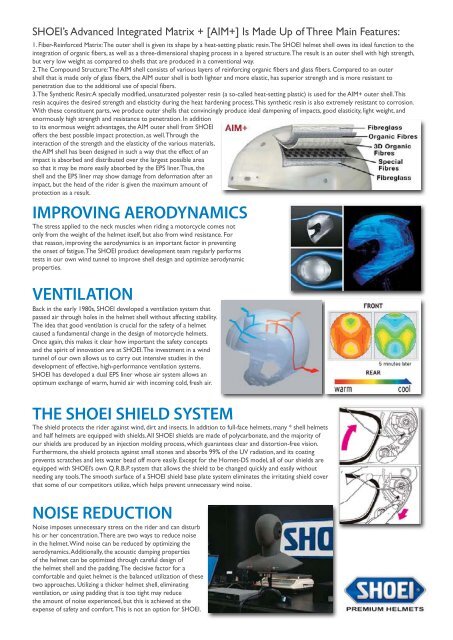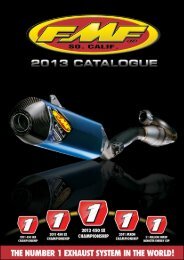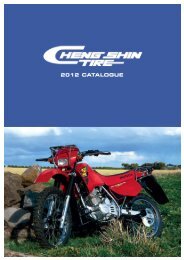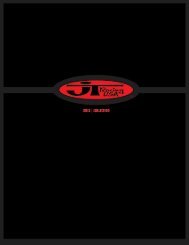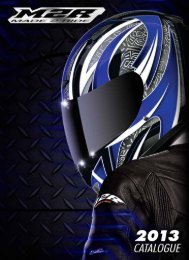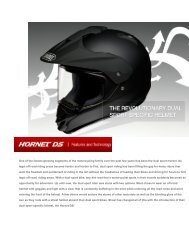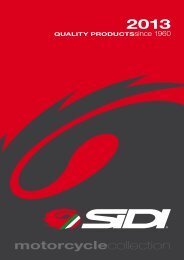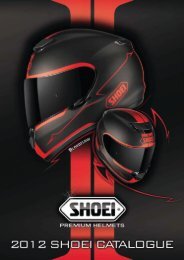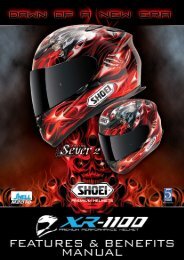Shoei Ibaraki Factory - McLeod Accessories
Shoei Ibaraki Factory - McLeod Accessories
Shoei Ibaraki Factory - McLeod Accessories
You also want an ePaper? Increase the reach of your titles
YUMPU automatically turns print PDFs into web optimized ePapers that Google loves.
SHOEI’s Advanced Integrated Matrix + [AIM+] Is Made Up of Three Main Features:<br />
1. Fiber-Reinforced Matrix: The outer shell is given its shape by a heat-setting plastic resin. The SHOEI helmet shell owes its ideal function to the<br />
integration of organic fibers, as well as a three-dimensional shaping process in a layered structure. The result is an outer shell with high strength,<br />
but very low weight as compared to shells that are produced in a conventional way.<br />
2. The Compound Structure: The AIM shell consists of various layers of reinforcing organic fibers and glass fibers. Compared to an outer<br />
shell that is made only of glass fibers, the AIM outer shell is both lighter and more elastic, has superior strength and is more resistant to<br />
penetration due to the additional use of special fibers.<br />
3. The Synthetic Resin: A specially modified, unsaturated polyester resin (a so-called heat-setting plastic) is used for the AIM+ outer shell. This<br />
resin acquires the desired strength and elasticity during the heat hardening process. This synthetic resin is also extremely resistant to corrosion.<br />
With these constituent parts, we produce outer shells that convincingly produce ideal dampening of impacts, good elasticity, light weight, and<br />
enormously high strength and resistance to penetration. In addition<br />
to its enormous weight advantages, the AIM outer shell from SHOEI<br />
offers the best possible impact protection, as well. Through the<br />
interaction of the strength and the elasticity of the various materials,<br />
the AIM shell has been designed in such a way that the effect of an<br />
impact is absorbed and distributed over the largest possible area<br />
so that it may be more easily absorbed by the EPS liner. Thus, the<br />
shell and the EPS liner may show damage from deformation after an<br />
impact, but the head of the rider is given the maximum amount of<br />
protection as a result.<br />
IMPROVING AERODYNAMICS<br />
The stress applied to the neck muscles when riding a motorcycle comes not<br />
only from the weight of the helmet itself, but also from wind resistance. For<br />
that reason, improving the aerodynamics is an important factor in preventing<br />
the onset of fatigue. The SHOEI product development team regularly performs<br />
tests in our own wind tunnel to improve shell design and optimize aerodynamic<br />
properties.<br />
VENTILATION<br />
Back in the early 1980s, SHOEI developed a ventilation system that<br />
passed air through holes in the helmet shell without affecting stability.<br />
The idea that good ventilation is crucial for the safety of a helmet<br />
caused a fundamental change in the design of motorcycle helmets.<br />
Once again, this makes it clear how important the safety concepts<br />
and the spirit of innovation are at SHOEI. The investment in a wind<br />
tunnel of our own allows us to carry out intensive studies in the<br />
development of effective, high-performance ventilation systems.<br />
SHOEI has developed a dual EPS liner whose air system allows an<br />
optimum exchange of warm, humid air with incoming cold, fresh air.<br />
THE SHOEI SHIELD SYSTEM<br />
The shield protects the rider against wind, dirt and insects. In addition to full-face helmets, many * shell helmets<br />
and half helmets are equipped with shields. All SHOEI shields are made of polycarbonate, and the majority of<br />
our shields are produced by an injection molding process, which guarantees clear and distortion-free vision.<br />
Furthermore, the shield protects against small stones and absorbs 99% of the UV radiation, and its coating<br />
prevents scratches and lets water bead off more easily. Except for the Hornet-DS model, all of our shields are<br />
equipped with SHOEI’s own Q.R.B.P. system that allows the shield to be changed quickly and easily without<br />
needing any tools. The smooth surface of a SHOEI shield base plate system eliminates the irritating shield cover<br />
that some of our competitors utilize, which helps prevent unnecessary wind noise.<br />
NOISE REDUCTION<br />
Noise imposes unnecessary stress on the rider and can disturb<br />
his or her concentration. There are two ways to reduce noise<br />
in the helmet. Wind noise can be reduced by optimizing the<br />
aerodynamics. Additionally, the acoustic damping properties<br />
of the helmet can be optimized through careful design of<br />
the helmet shell and the padding. The decisive factor for a<br />
comfortable and quiet helmet is the balanced utilization of these<br />
two approaches. Utilizing a thicker helmet shell, eliminating<br />
ventilation, or using padding that is too tight may reduce<br />
the amount of noise experienced, but this is achieved at the<br />
expense of safety and comfort. This is not an option for SHOEI.


